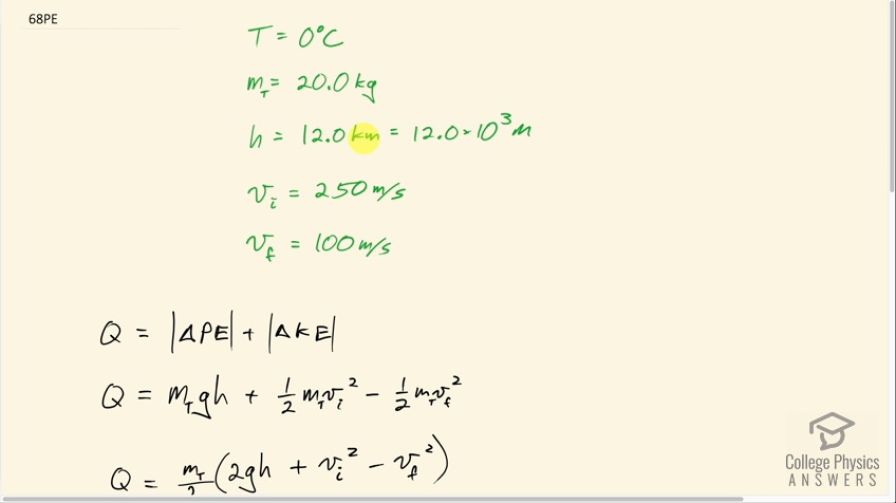Question
Frozen waste from airplane toilets has sometimes been accidentally ejected at high altitude. Ordinarily it breaks up and disperses over a large area, but sometimes it holds together and strikes the ground. Calculate the mass of ice that can be melted by the conversion of kinetic and gravitational potential energy when a 20.0 kg piece of frozen waste is released at 12.0 km altitude while moving at 250 m/s and strikes the ground at 100 m/s (since less than 20.0 kg melts, a significant mess results).
Final Answer
Solution video
OpenStax College Physics, Chapter 14, Problem 68 (Problems & Exercises)

vote with a rating of
votes with an average rating of
.
Calculator Screenshots
Video Transcript
This is College Physics Answers with Shaun Dychko. 20.0 kilograms of frozen toilet waste from an airplane is falling from an initial height of 12.0 kilometers which is 12.0 times 10 to the 3 meters. It starts with a speed of 250 meters per second and just before it hits the ground, it has its speed reduced to 100 meters per second and this is presumably due to friction and there's gonna be some heat provided by friction and that's gonna be melting some of the frozen waste. It has a temperature of 0 degrees Celsius initially and this detail means that all the energy that it loses due to gravitational potential energy being lost and due to kinetic energy being lost all of that goes directly into the phase change from ice to liquid— there's no need for the energy to be absorbed to change temperature. Okay! So the total heat that's going to be absorbed is going to be the change in potential energy plus the change in kinetic energy and I put absolute value bars here just to avoid negative sign issues; we know that this potential energy is going to be reduced and that's going to be turned into heat so it's going to be a positive amount of heat and we know the kinetic energy is also going to be reduced so this ΔkE is technically going to be a negative number but we just wanted magnitude... we wanna make it just positive because that's going to be the amount added to this heat as well. So we have the heat then is gonna be the total mass times g times h—that's the change in potential energy— plus one-half total mass times initial speed squared minus one-half total mass times final speed squared. So this is how much kinetic energy is lost but written as a positive number by putting the initial speed before the final. So we can factor out the total mass over 2 from all the terms and we have to introduce the number 2 here if we wanna do that and so we have total mass over 2 equals or times 2gh plus v i squared minus v f squared; all of this equals the heat absorbed. So heat absorbed goes directly into phase change and so that's gonna equal the mass of water that's melted multiplied by the latent heat of fusion and we can replace Q with this and we do that here and now we can figure out the mass that's melting by dividing both sides by latent heat of fusion. So the melted mass then is the total mass that we start with divided by 2 times the latent heat of fusion times 2gh plus v i squared minus v f squared. So that's 20.0 kilograms divided by 2 times 334 times 10 to the 3 joules per kilogram times 2 times 9.8 newtons per kilogram times 12.0 times 10 to the 3 meters plus 250 meters per second— initial speed squared— minus 100 meters per second—final speed squared just before it hits the ground— and that is 8.61 kilograms. So there's still gonna be a chunk of ice that's, you know, 11.39 kilograms of mass that's going to be hitting a single spot and creating quite a mess.
